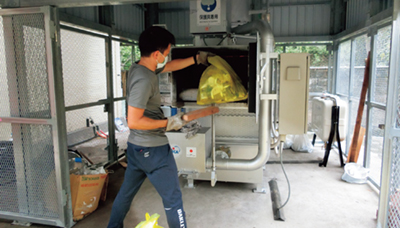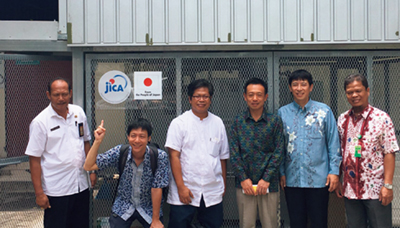Master Techniques from Japan to the World 4
The Active Use of a Compact Fully Automated Smokeless Incinerator in Indonesia
– Prevention of Environmental Contamination by Decontaminating Dangerous Medical Waste
Indonesia, comprised of roughly 13,000 islands, is located in the southern part of Southeast Asia. It boasts the third largest land area in Asia with the fourth highest population in the world at approximately 255 million people, and has seen sustained economic growth over the past 20 years. On the other hand, it is the second largest source in the world for plastic waste*1 released into the ocean. The volume of waste discharged by the country is constantly increasing, primarily in major cities, and recycling, incineration, and landfilling is not being properly carried out. Furthermore, because of labor and costs required for waste collection and management when transporting it from various islands to the final treatment plants, frequent and illegal dumping has been observed. With the government and incineration facilities unable to keep up with demand, waste is landfilled at treatment plants via open dumping (haphazard dumping) without separation, deepening sanitation and environmental problems caused by the waste. Among these issues, the proper treatment of medical waste is becoming an extremely urgent issue.

Garbage being inserted into the Chirimeser, small-sized incinerator(Photo: Thomas Technical Institute Co., Ltd.)
Mr. Kenji Fukutomi, CEO of Thomas Technical Institute Co., Ltd. in Okinawa Pref., proposes a small scale incinerator that can process waste without waste sorting for Indonesia which is similar to Okinawa with its many remote islands. Usually it is difficult to operate and manage incinerators on remote islands, as all types of waste must be processed by incinerators and many such cases result in the damage to the incinerators themselves, making them unusable. It generates concern that Indonesia is faced with the same situation.

Members of Wangaya Regional General Hospital in front of the Chirimeser building (Mr. Fukutomi is second from the right)(Photo: Thomas Technical Institute Co., Ltd.)
Born and raised on Amami Oshima Island, Mr. Fukutomi developed the Chirimeser incinerator to resolve the challenges faced by residents of remote islands who were struggling to process waste such as trash that accumulated on beaches from the ocean. The product, which won the 2006 Minister of the Environment Award of Japan, enables the incineration of any waste without releasing smoke while limiting harmful emissions.*2 It is also completely automated*3 and can be installed easily, making it usable by anyone. To date, it has been delivered for use to over 70 entities, including local governments in Japan primarily in Okinawa Pref. but also to remote islands in Saga and Nagasaki prefectures and other remote mountainous regions. Mr. Fukutomi explains that the Chirimeser should be able to meet the waste treatment needs of remote islands in Indonesia as well. An additional benefit of the Chirimeser is that the volume of ashes remaining after incineration is only 1/100 of the original waste volume, reducing the cost of transportation of aches to the final treatment plant.
As the Chirimeser is particularly adept at handling the treatment of medical waste, which requires very careful handling, one Chirimeser was installed at Wangaya Regional General Hospital in Denpasar, the second largest hospital in Bali, in December 2016 under a proposal to the JICA's Support for Japanese Small and Medium-sized Enterprises (SMEs) Overseas Business Development, named “Verification Survey with the Private Sector for Disseminating Japanese Technologies for Compact Environmentally Friendly Incinerators in Island Regions.” The Chirimeser is capable of incinerating approximately 250 kg of medical waste per unit per day. Previously, Wangaya Regional General Hospital discharged black smoke because of the daily improper burning of 100 kg medical waste, causing constant complaints from surrounding residents of exhaust gas contamination and unpleasant odors. These complains resulted in the limitation of operation of the hospital's incinerator. Furthermore, since residue from the incineration was being carried to the final treatment plant in Bogor in Java Island without adequate sanitization due to the low incineration temperature, there was concern over the risk of the spread of infectious disease along the transportation route and at the plant. The use of the Chirimeser has greatly improved these issues. Surprised by the positive results, Indonesian government officials and hospital workers began to consider the full-scale installation of incinerators. As other hospitals also face similar issues, the successful demonstration of Chirimeser is expected to lead to the replacement of incinerators at multiple hospitals in the city.
Through his passionate efforts to “reduce and decontaminate the burned garbage as much as possible without releasing smoke,” Mr. Fukutomi explains his hopes to “share the high technological capabilities and power of manufacturing in Okinawa with the world. I want to seriously make efforts to enter into the Southeast Asian market, centered on Indonesia, where waste disposal problem is obvious and social demand for improving sanitation is rising.”
*1 The total volume of plastic waste released into the world's oceans is between 4.8 and 12.7 million tons annually. China leads with approximately 28% of the world total, followed by Indonesia in 2nd place (approximately 10%) with Japan in 30th place (approximately 0.4%). The volume released from shorelines in 192 countries and regions bordering oceans, rather than the volume floating in the ocean, was surveyed and analyzed by a research team from the University of Georgia in the U.S. (2010 survey).
*2 For example, dioxin emissions are reduced to 1/50th of the regulated limit (according to Japanese law).
*3 An automation system developed with patented technology that is used to control the temperature, smoke density, and incineration speed. The incinerator detects its own operational state to improve incineration efficiency and achieve optimal operation.
<< Previous Page Next Page >>
Main Text | Statistics and Reference Materials | Stories from the Field | Master Techniques from Japan to the World | ODA Topics
